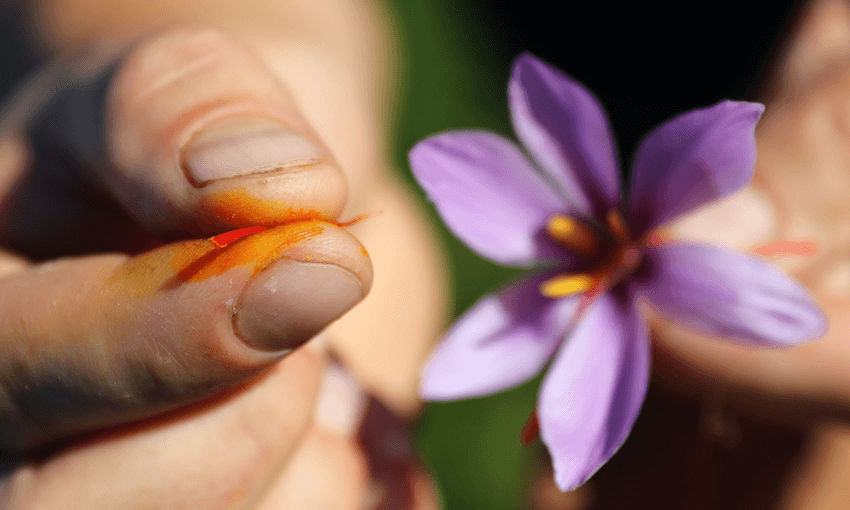The laborious hand-harvesting process that makes saffron so pricey hasn’t put off some enterprising growers in Aotearoa. Olivia Sisson pays a visit to a saffron operation in Canterbury.
When rapper 2 Chainz asked this business to make pickles for his show Most Expensivest Things, they put heaps of saffron in the brine.
Saffron is the world’s priciest spice. According to Business Insider, one kilo costs about $NZ15,000. Half-gram containers at New World set you back $10.
So what is saffron and why is it so dear? The MasterFoods packaging offers no answers.
Saffron is the red stigma of the stunning purple flower Crocus sativus. Each crocus flower contains three thread-like stigmas, which must be plucked out by hand. Per Business Insider’s calculations, 150,000 flowers are required to produce one kilogram of saffron.
The labour-intensive harvest and saffron’s many uses both factor into its cost. Saffron was likely discovered in Bronze Age Greece, but is now grown throughout Europe, Asia and even New Zealand. Adding a golden hue and imparting a subtle, almost musty hay-like flavour, it’s prized all over the world and features in dishes like Spanish paella, Moroccan couscous, Afghani pulao and Swedish saffransbröd (sweet buns). America’s Pennsylvania Dutch add it to scalloped potatoes and chicken pot pies.
In addition to food, there’s almost nothing saffron hasn’t been used for over the course of history. Cleopatra was known to bathe in a mixture of mare’s milk and saffron before suitors called in. Alexander The Great used it to treat his battle wounds. Minoan women made lipstick with its pigment and the Romans sprinkled it in public spaces to improve the smell for Emperor Nero.
Recent studies have shown saffron may help treat depression, inflammation and sexual dysfunction. In 2020, London burglars made off with $60,000 worth of it in a well-documented spice heist.
While the vast majority of the world’s saffron comes from Iran, a handful of New Zealand growers specialise in small-quantity, high-quality product.
According to Dr Graham Strong of Wynward Estate Saffron, the crop was initially tested here by Crop and Food Research. They found it grew best in Clyde thanks to the hot summers and deep winters. Growers in similar climates sprouted up from there.
Today, saffron is grown in Otago, Wairarapa, Marlborough, Hawke’s Bay and Canterbury. A visit to one grower shed light on how rewarding – but also how demanding – saffron cultivation is.
Lois and Selwyn Dobbinson run Lassad Saffron on their lifestyle block outside of Ōtautahi Christchurch.
As Selwyn says, saffron is easy to grow, but much harder to harvest and sell.
To get a crop going you just need to plant out some Crocus sativus “corms”, which look a bit like tulip bulbs. The plants look after themselves for the most part, Selwyn says, and lots of New Zealand growers sell starter corms if you want to have a go. Although you’ll need quite a few to get any kind of quantity of the end product.
Once you’ve planted your corms you must stay on top of the weeds and wait.
“The thing that has always amazed me about this crop is that one minute there will be nothing to see. Then one day I come back in the morning and there the purple flowers are. Just think of how complex the flower is, and it comes up in 24 hours. It’s totally impressive,” Selwyn says. “There must be a word for that magic.”
When the flowers start to pop up in late March, the fervent harvest begins. It’s painstaking work that lasts six weeks.
During harvest time, Selwyn and Lois rise early and rarely get to bed before midnight. You have to harvest the flowers first thing in the morning before they open, Selwyn says. The chemical compound that gives saffron its flavour is UV sensitive. It begins to degrade as soon as the sun’s rays hit it.
In the evenings, the duo process the flowers, removing each precious stigma by hand. From there, Lois carefully dries the saffron. Rather than chucking the flower petals away, she uses them to make some seriously effective hand/heel cream.
This year the couple picked and processed about 8,000 flowers. “Don’t drop that,” Lois laughs as Selwyn proudly shows off the harvest on a platter.
The saffron that Lassad and many other NZ producers grow is high-grade stuff, Selwyn says. Some imported (and often supermarket) products have been sprayed, or dried in the sun, meaning the spice’s full potency has been lost. Yellow stigmas, which are less flavourful, are also sometimes included to bulk up the weight.
Lois and Selwyn sell their incredible product at local Christchurch markets. If you’re outside of Christchurch and keen to try it, just flick Lois an email (lassadltd@gmail.com). She’ll post it directly.
When you get your saffron, have fun with it. Lois likes to use it in panna cotta. She’s even flavoured gin with it. As many cultures can attest to, saffron makes vibrant, aromatic and special rice dishes. But don’t go chucking it all in at once. Only a few threads are needed.
To draw out saffron’s full power, Wendy King from Wynward Estate Saffron recommends infusing it into a bit of water and then adding that to whatever dish you’re making.
“The infusion is the most important part – leaving it for 24 hours will give the best result, but if you’re pushed for time use an acid like yoghurt, cream or alcohol.”

